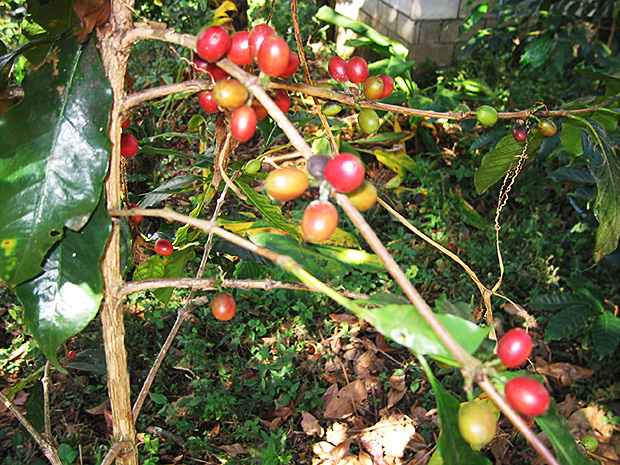In the morning, many people need to have their coffee. They spend that time planning what to do with their day. Sometimes, they try to go without coffee and their minds go blank. Coffee is special. It does its job well but in a contradictory way. It makes your body alert and relaxed at the same time.
Coffee may seem addictive, but it comes with a lot of benefits. It creates bonds in society, awareness of news, and jobs for groups of people everywhere.
Take a look at coffee in Thai society in the old days when Thais began drinking coffee outside the home. Coffee shops were scattered throughout the community. Almost all coffee vendors were Chinese. These shops also looked very much the same. There's a pot with boiling water, with steam rising. Inside the kettle is a bag filled with coffee. To get the coffee, you simply pour hot water into the bag, pour the liquid into a cup and serve it. A successful coffee shop needed to keep their pot full, always making sure the water is boiled. Coffee is added constantly into the bag as well, making its flavour stronger. With the right flavour, more and more customers would come.
In shops where business is rather slow, they may not bother with keeping the water boiled. When coffee is left in the kettle too long, it turns stale and sour.
There's a type of coffee that we put sweetened condensed milk in, and we call it "hot coffee". If we put sugar instead, we call it "black coffee". A coffee shop is a gathering place for people in the community. In the past, news didn't move as fast or was as quickly updated as it is today. So, the morning was usually the time when people would come together to discuss topics such as business, civil service, agriculture, price of goods and tourism.


Ground coffee.
The next generation of coffee shops came with newspapers readily available. Customers would read the news and then express their opinions. If the topic was politics, the coffee shop turned into something of a small parliament.
A coffee shop can also be a place where people look for jobs. More than 50 years ago, on Saipad Road in Yaowarat, there was a shop called Ia Sae, which opened at 5am. Its customers were owners of Chinese restaurants and cooks who came to the Yaowarat old market to buy fresh and dried ingredients. After running errands, they'd stop for coffee, also to exchange news within the food business and even to look for workers.
Workers, too, came for coffee and had an opportunity to meet with restaurant owners and cooks. Ia Sae became a hub for people in the food business. This is an example of how the business of coffee shops began to grow.
Later, there came an age when people drank coffee inside the comfort of their own homes. A variety of instant coffee was available. People would drink their coffee while watching news on TV. Shops that made their coffee in a bag were called boran (old) and their popularity began to fade.
From instant coffee inside our homes and offices, then, came the age of freshly ground coffee beans. At first, it was robusta coffee, which was widely grown in the South and sold in Bangkok. One coffee brand, Tung Hu, was very popular. Those who prefer this type of coffee may have a coffee machine in their house. A price to pay, but it's not much of a problem if they can get fragrant and rich coffee. Later on, coffee machines became cheaper. There were many types to choose from. And so we fully entered the age of ground coffee.

Hot coffee, made in a bag, is the oldfashioned way.
Coffee became an important commercial plant. Beginning 30 years ago, land that was used to grow opium was converted to grow coffee. HM King Rama IX planted the first arabica tree at Doi Inthanon, and encouraged them to be planted elsewhere. The German government also helped in planting coffee at Doi Wavi and Doi Chang in Chiang Rai. After that, arabica coffee spread throughout the North.
Somsak Kireephumthong, a Karen villager at Mae Klang Luang on Doi Inthanon, Chiang Mai, came up with a way to grow organic coffee without using fertiliser and insecticides. He grew coffee trees together with mango and lychee trees. When the coffee tree starts bearing fruit -- all yellow and sweet-tasting -- it draws aphids and other insects that eat those young fruits. However, mango and lychee trees draw fire ants that feed on aphids. So, Somsak doesn't need to use insecticides. The manufacturing processes that followed were of traditional methods that constantly improved.
Today, we can consider it the golden age of coffee, especially for mountain villagers. The amount of coffee consumed is staggering. There are coffee shops everywhere. Competition is high. People communicate quickly via internet. People who operate coffee shops don't buy their beans from wholesalers, but rather go up the mountains to the source. They offer advice on the process to ensure the coffee's quality. This is how coffee growers became successful.
Coffee drinkers now pick the best coffee. Sellers also have to adjust themselves. People don't really make their coffee in a bag anymore. They even turn to the Moka pot and French Press. Coffee is not just another drink, but it carries a history, and is constantly evolving and moving forward.

